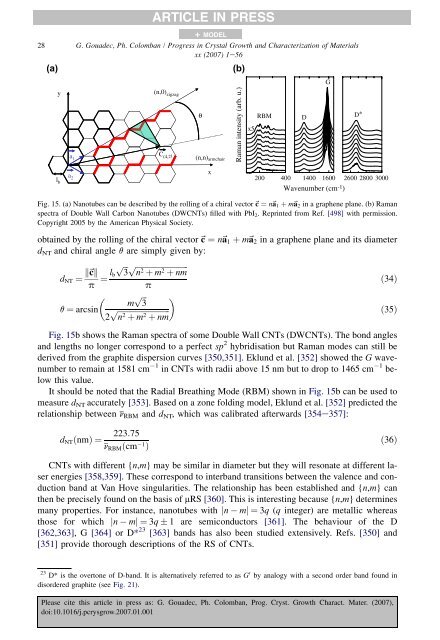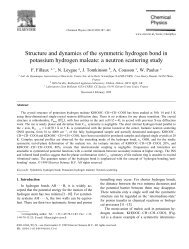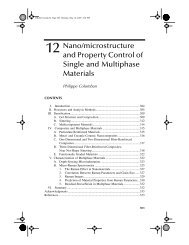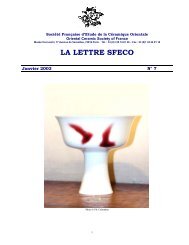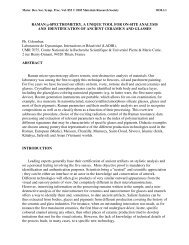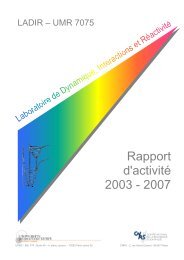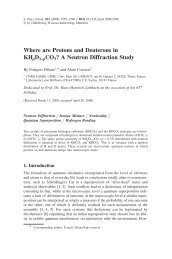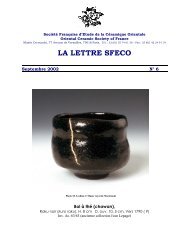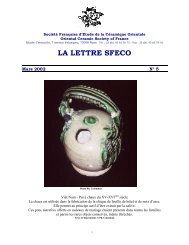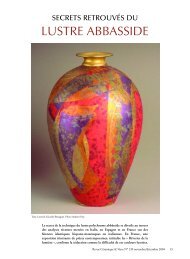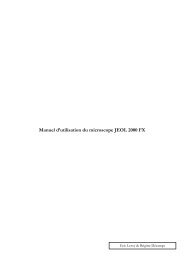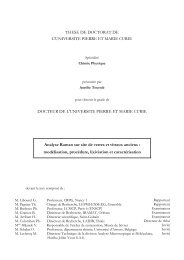(a)y (n,0) zigzagθa 1(n,n) armchairxl 200 400 1400 1600 2600 2800 3000bWavenumber (cm -1 )a 2C (4,2 )obtained by the rolling <strong>of</strong> the chiral vector ~c ¼ n~a 1 þ m~a 2 in a graphene plane and its diam<strong>et</strong>erd NT and chiral angle q are simply given by:d NT ¼ k~ckp ¼ l pffiffiffipffiffiffiffiffiffiffiffiffiffiffiffiffiffiffiffiffiffiffiffiffiffiffiffiffiffib 3 n 2 þ m 2 þ nmð34Þp p q ¼ arcsinffiffi3mp2 ffiffiffiffiffiffiffiffiffiffiffiffiffiffiffiffiffiffiffiffiffiffiffiffiffiffin 2 þ m 2 þ nmARTICLE IN PRESS+ MODEL28 G. Goua<strong>de</strong>c, Ph. Colomban / Progress in Crystal Growth and Characterization <strong>of</strong> Materialsxx (2007) 1e56Fig. 15. (a) Nanotubes can be <strong>de</strong>scribed by the rolling <strong>of</strong> a chiral vector ~c ¼ n~a 1 þ m~a 2 in a graphene plane. (b) <strong>Raman</strong>spectra <strong>of</strong> Double Wall Carbon Nanotubes (DWCNTs) filled with PbI 2 . Reprinted from Ref. [498] with permission.Copyright 2005 by the American Physical Soci<strong>et</strong>y.Fig. 15b shows the <strong>Raman</strong> spectra <strong>of</strong> some Double Wall CNTs (DWCNTs). The bond anglesand lengths no longer correspond to a perfect sp 2 hybridisation but <strong>Raman</strong> mo<strong>de</strong>s can still be<strong>de</strong>rived from the graphite dispersion curves [350,351]. Eklund <strong>et</strong> al. [352] showed the G wavenumberto remain at 1581 cm 1 in CNTs with radii above 15 nm but to drop to 1465 cm 1 belowthis value.It should be noted that the Radial Breathing Mo<strong>de</strong> (RBM) shown in Fig. 15b can be used tomeasure d NT accurately [353]. Based on a zone folding mo<strong>de</strong>l, Eklund <strong>et</strong> al. [352] predicted therelationship b<strong>et</strong>ween n RBM and d NT , which was calibrated afterwards [354e357]:(b)<strong>Raman</strong> intensity (arb. u.)x5RBMDGD*ð35Þd NT ðnmÞ¼ 223:75n RBM ðcm 1 Þð36ÞCNTs with different {n,m} may be similar in diam<strong>et</strong>er but they will resonate at different laserenergies [358,359]. These correspond to interband transitions b<strong>et</strong>ween the valence and conductionband at Van Hove singularities. The relationship has been established and {n,m} canthen be precisely found on the basis <strong>of</strong> mRS [360]. This is interesting because {n,m} <strong>de</strong>terminesmany properties. For instance, nanotubes with jn mj¼3q (q integer) are m<strong>et</strong>allic whereasthose for which jn mj¼3q 1 are semiconductors [361]. The behaviour <strong>of</strong> the D[362,363], G[364] or D* 23 [363] bands has also been studied extensively. Refs. [350] and[351] provi<strong>de</strong> thorough <strong>de</strong>scriptions <strong>of</strong> the RS <strong>of</strong> CNTs.23 D* is the overtone <strong>of</strong> D-band. It is alternatively referred to as G 0 by analogy with a second or<strong>de</strong>r band found indisor<strong>de</strong>red graphite (see Fig. 21).Please cite this article in press as: G. Goua<strong>de</strong>c, Ph. Colomban, Prog. Cryst. Growth Charact. Mater. (2007),doi:10.1016/j.pcrysgrow.2007.01.001
ARTICLE IN PRESS+ MODELG. Goua<strong>de</strong>c, Ph. Colomban / Progress in Crystal Growth and Characterization <strong>of</strong> Materialsxx (2007) 1e564.4. Nanophased SiC fibres29SiC fibres, which are among the most stable inorganic fibres, are mostly produced by the 3Dr<strong>et</strong>iculation <strong>of</strong> a polymeric precursor. 24 Their nano-crystalline structure <strong>of</strong>fers the best compromiseb<strong>et</strong>ween a good homogeneity (a characteristics <strong>of</strong> the amorphous state) and a high bond<strong>de</strong>nsity (a characteristics <strong>of</strong> the crystalline state). Their very smooth surface and the lack <strong>of</strong> <strong>de</strong>fectsexplain tensile strengths s r as high as 3 GPa. These fibres are <strong>de</strong>signed to reinforce compositesworking at very high temperatures (w1200 to 1400 C) in oxidizing and corrosiveatmospheres (carbon fibres oxidize at 500 C whereas alumina, zirconia and mullite fibres properties<strong>de</strong>gra<strong>de</strong> above 1100e1200 C [365] as they crystallize).Micro-<strong>Raman</strong> <strong>Spectroscopy</strong> is particularly well suited to study SiC fibres because it givesa good signal for both the main SiC and the secondary carbon phases. Fig. 16a illustratesthis fact by the monitoring <strong>of</strong> the SiC <strong>de</strong>carburation in NLM fibres submitted to alkaline corrosion.First, the different forms <strong>of</strong> partially oxidized or nitri<strong>de</strong>d carbon can be i<strong>de</strong>ntified [23].The SiC spectrum mainly consists <strong>of</strong> peaks around 795 and 970 cm 1 . They correspond respectivelyto the transverse optical (TO 1 and TO 2 ; <strong>de</strong>generate) and longitudinal optical (LO) mo<strong>de</strong>s<strong>of</strong> b-SiC 25 , which X-ray diffraction i<strong>de</strong>ntified in Nicalon (NLM, Hi and HieS) [369], SA[370]and Sylramic [371] fibres. Additional bands correspond to SiC polytypes (see Fig. 17: the BrillouinZone folding generates satellite lines on the low energy si<strong>de</strong> <strong>of</strong> the TO and LO bands[212,213,372e377]), to amorphous SiC (broad symm<strong>et</strong>ric background) and to asymm<strong>et</strong>ricVDOS projections when a ‘‘random’’ faulting in the stacking sequence folds the BZ in countlessways [372].The SiC contributions in the spectra in Fig. 16b were fitted using the PCM (see Section 3.3.1).This r<strong>et</strong>urned ‘‘coherence lengths’’ <strong>of</strong> 6.5 1.2 nm (TO) or 3.8 0.9 nm (LO), in good agreementwith the size <strong>of</strong> SiC polytype domains appearing in Fig. 16c. We performed similar fitson spectra <strong>of</strong> HieS, SA and Sylramic nearly stoichiom<strong>et</strong>ric third generation SiC fibres [378], obtainedfrom grafted polycarbosilane [370,379e382]. Only the HieS bands could not be adjustedat ~k 0 ¼ ~0, hinting at a greater stacking disor<strong>de</strong>r. The coherence length was higher for Sylramicand SA fibres, in agreement with a higher grain size (100e500 nm [380] and 200 nm [383],respectively, against 20 nm in the HieS [379]).4.5. CeO 2The electrical properties and chemical reactivity <strong>of</strong> nano-crystalline CeO 2 make it interestingfor applications such as gas sensor, fuel cells electrolyte material, catalyst for oxygen storage,<strong>et</strong>c. [153,196,215]. Ceria only first or<strong>de</strong>r <strong>Raman</strong> active mo<strong>de</strong> is the triply <strong>de</strong>generatesymm<strong>et</strong>rical str<strong>et</strong>ching vibration <strong>of</strong> the CeO 8 vibrational unit at w465 cm 1 . Only the oxygenatoms move in this mo<strong>de</strong> [153,196,215], which is therefore very sensitive to the oxygen24 The main alternative is Chemical Vapour Deposition (CVD) <strong>of</strong> SiC on a carbon fibre core (SCS-6 fibre fromTextron).25 In SiC structures, Si and C ‘‘bilayers’’ are referred to as ‘‘h’’ if they are <strong>de</strong>duced from the un<strong>de</strong>rlying bilayer bya simple translation. However, if an additional 180 rotation (around the SieC bonds linking the bilayers) is requiredfor superposition, then bilayers are referred to as ‘‘k’’. Each periodic stacking sequence <strong>de</strong>fines a polytype which is classifiedaccording to Rams<strong>de</strong>ll notation by first giving the number N <strong>of</strong> bilayers in the stacking cell and then the cell type[366e368]. The ‘‘all k’’ polytype (b-SiC phase) is the 3C (cubic) polytype. All other polytypes (a-SiC phase) are eitherNH (hexagonal) or NR (rhombohedral).Please cite this article in press as: G. Goua<strong>de</strong>c, Ph. Colomban, Prog. Cryst. Growth Charact. Mater. (2007),doi:10.1016/j.pcrysgrow.2007.01.001


